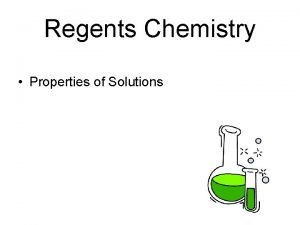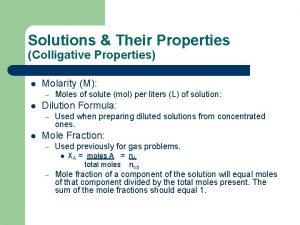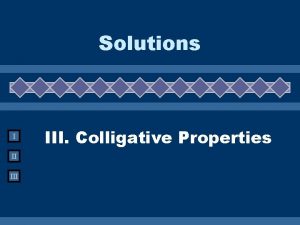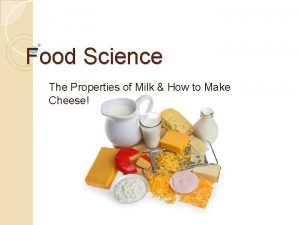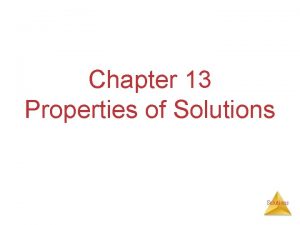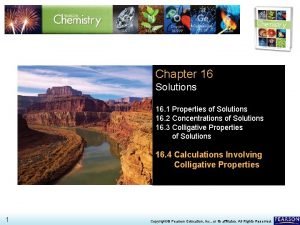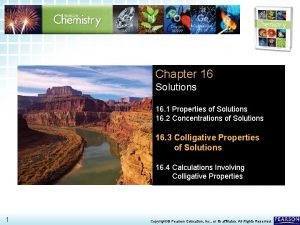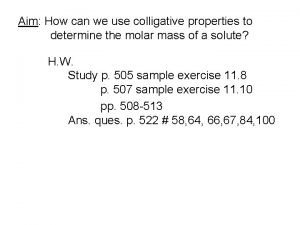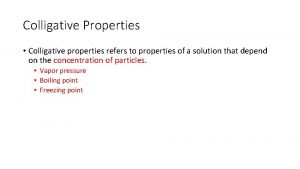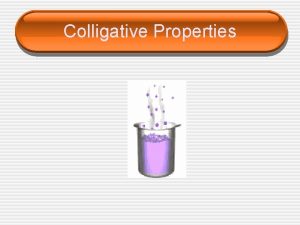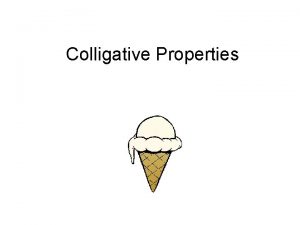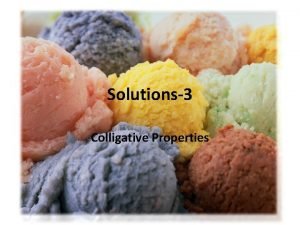Electrolytes and Colligative Properties Mr Shields Regents Chemistry


















- Slides: 18

Electrolytes and Colligative Properties Mr. Shields Regents Chemistry U 12 L 07 1

Electrolytes There a number of different kinds of pure Substances that can be dissolved in solvents to Produce solutions. -Some of these substance involve dissolving covalent molecules in liquids examples: O 2, C 6 H 14, C 6 H 12 O 6, CCL 4 -Some of them involve dissolving ionic compounds in liquids examples: Na. Cl, NH 4 Cl, KI 2

There is a difference between how these two types of solutes dissolve in a polar liquid such as water. Molecular compounds… - remain as single entities in solution Ionic Compounds … - separate into the ions from which they are made The Separation of a compound into it’s IONS is called DISSOCIATION 3

Electrolytes Compounds that produce ions in solution by dissociation are Called… 4 ELECTROLYTES

Notice that when a compound dissociates the resulting Solution has more particles in it than what we started with: Dissolving equations: NH 4 Cl + H 20 NH 4+ (aq) + Cl- (aq) K 2 SO 4 + H 20 2 K+ (aq) + SO 4 -2 (aq) 1 particle 2 particles 1 mole 2 moles 1 particle 3 particles 1 mole 3 moles How many moles of particles do I have if I dissolve 1 mole of Al(NO 3)3 in water? What is the dissolving Equation? How many moles of particles do I have if I dissolve 1 mole of Sucrose in water? (sucrose = C 12 H 22 O 11) 1 C 12 H 22 O 11 +H 20 C 12 H 22 O 11 (aq) 5

An important property of ionic compounds in solution is that They Conduct electricity. - Molecular compounds in solution DO NOT In other words, Electrolytes form conductive solutions but Non-electrolytes do not When the ends of an electric circuit are placed in a Solution of an Electrolyte 2 things happen… 6

Conduction of electricity 1) Positive ions will flow towards the negative electrode 2) Negative ions will flow toward the positive electrode + This free flow of ions Allows electricity to Be conducted through The solution Molecules in solution Can’t do this! this Cl- + - ions - + ions - Na+ 7

Problem: 1) Which of the following are electrolytes and which are not? 2) How many particles does each produce in Solution? 1) Ethyl Alcohol 2) (C 2 H 5 OH) 3) 2) Na. Cl 4) 3) Sugar 4) Cu. SO 4 5) Al. Cl 3 6) NH 4 NO 3 7) Al 2(SO 4)3 8

Colligative Properties Now… When substances dissolve in liquids we change some Of the physical properties of the liquid These changes are DEPENDENT only on the Number of Solute particles present And … are INDEPENDENT of the nature or kind of solute Particles Non-polar Na. NO Ionic 3 lar u c e l o M CH 3 CCL 4 CH 3 CH Na. Cl 2 OH r Pola 9

Colligative Properties For example: 2 moles of sugar (C 12 H 22 O 11) in water would have the same impact on the solvent’s properties as 1 mole of Na. Cl. So, if changes in properties are dependent only on the number of solute particles in solution why is the above true? 10

Properties that are dependent on the # of particles but Are Independent of the nature of the particle are known as COLLIGATIVE PROPERTIES When comparing the properties of a pure solvent vs. the Properties of solution made with the same solvent there are 2 colligative properties of special interest that are Observed to change: 1) The freezing pt. which decreases 2) The boiling pt. which increases 11

Problem: a) Which sol’n will have the greatest effect on FP & BP? b) how much greater? How many moles of ions are in solution c) for each? 1) 2 M KBr 2) 0. 5 M Na. Cl b) Which sol’n will have the greatest effect on FP & BP? 1) 2) 3) 4) 5) 1 M Cu. SO 4 2 M Na. Cl 3 M Sugar 2 M Ca. F 2 5 M C 2 H 5 OH 2 M particles 4 M “ 3 M “ 6 M “ 5 M “ 12

BP Elevation The Elevation of Boiling Point (BPE) is one of the Colligative Properties of solutions So … What’s the definition of the Normal Boiling Point? The NBP is the temperature at which the VP of the liquid Equals Standard Pressure (1 atm) 13

By adding solute to solvent the VP of the solvent is reduced. Therefore, it takes a higher temperature for the Vapor Pressure of the liquid To reach 1 Atm (i. e. the Boiling Point) T 1 T 2 Normal BP of Solvent w/o solute Normal BP of Solvent w/solute BP T 2 > T 1 14

Freezing Point Depression of Freezing Point is the second of the Colligative Properties of solutions we’ll discuss. First … what is the definition of the freezing Point? The FP is the temperature at which both solid and Liquid exist in equilibrium. This means that liquid becomes solid and solid becomes Liquid and this oscillates back and forth – in equilibrium 15

As the temperature is lowered the attractive forces between molecules become more significant. These forces organize liquid molecules into regular, repeating patterns. In other words into solids. This is what we call solidification (freezing). Solutes interfere With this process. T 1 In order to organize the Solvent molecules a lower Temperature is now T 2 Required. As the temp dec. molecular Motion slows down. The Attractive forces can now Overcome the disruptive force of the solute. 16

Seawater is about 3. 5% salts (ionic compounds) in water The freezing point of seawater is about 28. 4°F (-2°C), instead of the 32°F (0°C) freezing point of ordinary water And… As antifreeze is added To water in your cars Radiator the freezing Pt. is markedly depressed A molecule 17

Now you can appreciate why we add antifreeze (ethylene glycol) to our car’s cooling systems. By adding solute we Raise the BP of the water in the Cooling system AND at the same time Lower the FP of The water. So we can protecting our engines in both winter and summer. 18
 Solutions chemistry regents questions
Solutions chemistry regents questions Is molarity a colligative property
Is molarity a colligative property Ions in aqueous solutions and colligative properties
Ions in aqueous solutions and colligative properties Dot
Dot Colligative properties definition
Colligative properties definition Raoult's law derivation class 12
Raoult's law derivation class 12 Colligative properties of milk
Colligative properties of milk Non colligative properties examples
Non colligative properties examples Colligative properties worksheet
Colligative properties worksheet Van’t hoff factor
Van’t hoff factor Colligative properties
Colligative properties Colligative properties depend on the _____.
Colligative properties depend on the _____. Colligative properties depend on
Colligative properties depend on Calculations involving colligative properties
Calculations involving colligative properties 3 colligative properties
3 colligative properties Costherm
Costherm Colligative properties calculator
Colligative properties calculator Calculating molar mass using colligative properties
Calculating molar mass using colligative properties Colligative properties notes
Colligative properties notes
